Embracing visions of progress, #BeyondGDP
The shortcomings of GDP have been widely recognised for several decades now, with a huge number and diversity of “alternative indicators of progress” being developed. In order to buy-in to a new indicator of progress, we don’t just need a new indicator. We need a new way of thinking about societal wellbeing that is grounded in sustainability and just distribution, Christine Corlet Walker writes, introducing hers and Tim Jackson’s latest working paper, navigating the options.
The first ministers of New Zealand and Scotland have recently pledged anew to change the way they measure the success of their economies and the prosperity of their countries. Jacinda Ardern has presided over the deployment of the New Zealand Living Standards Framework, which aims to capture the wellbeing of New Zealanders today, as well as keeping track of what will be handed down to future generations. While Nicola Sturgeon has explicitly called for an end to our obsession with GDP, and the beginning of a “much broader definition of what it means to be a successful country”.
In the long and shadowy wake of the financial crisis, and under the looming clouds of a climate crisis, something seems, finally, to be dawning on the ministers of these countries, among others. Perhaps this singular guiding light, which has been steering our policy and budgetary decisions since the 1930s, doesn’t quite capture the complexity and diversity of the wellbeing of our societies.
The consequences of this are significant. If we take GDP as a proxy for wellbeing—orienting all our policy towards preserving and maximising its growth—we are making decisions in a way that does not fully consider the value of unpaid domestic care, the importance of strong communities, or the fundamental foundation that the environment provides for all our economic activity. More than this, we may even be preventing effective climate action on the grounds that it would be damaging to economic growth. Or justifying the continued existence of inequality on the basis that the benefits of economic growth will ‘trickle down’ (eventually).
The shortcomings of GDP have been widely recognised for several decades now, with a huge number and diversity of “alternative indicators of progress” being developed to augment, compliment or replace GDP. These indicators have, however, remained on the side-lines of policy-making and budget setting, in spite of persistent efforts to bring them to the fore. None have so far been able to take the place of, or even hold court with, GDP on the main stage. Why is this?
In order to buy-in to a new indicator of progress, we don’t just need a new indicator. We need a new way of thinking about societal wellbeing that is grounded in sustainability and just distribution. We need a new economic modelling infrastructure built around these broader indicators of societal wellbeing and environmental risk. And we need a political class that is bold enough to embrace new visions of progress, beyond GDP.
To achieve all this, importantly, we also need action. Further development of alternative indicators of progress is important, yes. But arguably more important is that individuals and organisations take them up, share their messages with the public, and lobby for their use in government.
In the latest addition to the CUSP working paper series, Tim Jackson and I explore the existing ecosystem of alternative indicators of progress, laying a roadmap to navigate the diverse and numerous options. Amid discussions of whether or not to monetise nature, and whether it’s better to keep a dashboard of diverse indicators or try to pool them together into one, headline-grabbing number, we find that the purpose of these indicators sometimes gets lost.
Two common purposes of such indicators deserve particularly close attention: 1) those indicators that aim to tell new stories of progress; and 2) those indicators that aim to act as decision-aids for policy. Through this lens it becomes apparent that the characteristics that make a good story-telling indicator are not always the same as those that make a good decision-making indicator. If we want to use these alternative indicators of progress more effectively to ‘de-throne’ GDP, paying close attention to purpose and context is key.
Nicola Sturgeon and Jacinda Ardern’s new commitments to thinking more broadly about societal wellbeing are not changes on a whim. They are the result of a decade or more of work and campaigning, both within their governments and outside them. Changing the goal of government policy-making from GDP growth to a sustainable and just vision of wellbeing can sometimes feel like trying to turn a juggernaut from North- to South-facing. But these small steps remind us that maybe the trajectory of the bow is starting to bend.




